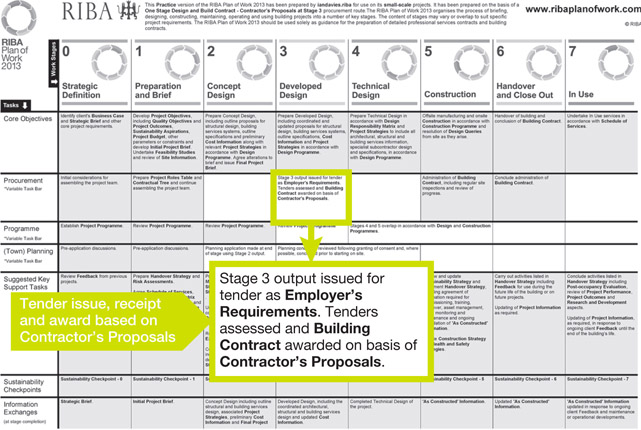Stage 3
Developed Design

Chapter overview

At Stage 3 the role of the contract administrator continues to be dependent on the procurement route selected at Stage 1.
During Stage 3 the Concept Design will be further developed through input from other members of the design team, to the point where a planning application could be made. There may be various iterations of the design during this period, but by the end of the stage the lead designer should have coordinated the scheme and arranged for it to be signed off by the client.
This chapter looks at what tasks the contract administrator would undertake at this stage and the differences between the tender documents required for one-stage design and build projects.
The key coverage in this chapter is as follows:
Introduction
During this stage the contract administrator will facilitate the successful receipt of competitive tenders for a one-stage design and build project so that the client can decide who should develop the detail and ultimately build the project.
Early in the stage the contract administrator should discuss the job-specific tender procedures with the client, so that the client is fully aware of the process and the implications for the contractors and the project.
The level of detail in the tender documents issued at this stage will be higher than in tender documents issued at an earlier stage as the design will be more developed. The role of the contract administrator in the selective tendering process together with works associated with the contract documents immediately prior to the awarding of the contract, will be similar to the traditional procurement route. These are described in the following chapter (Stage 4).
What are the Core Objectives of this stage?
The Core Objectives of the RIBA Plan of Work 2013 at Stage 3 are:

The Core Objective at Stage 3 is to develop the Concept Design to a stage where the design is coordinated and is suitable for making a planning application as appropriate. The design team will be required to complete the Developed Design such that it reflects the increased level of detail required and, depending on the procurement route, enables competitive tenders to be sought and the Building Contract awarded to the preferred contractor.
What supporting tasks should be undertaken during Stage 3?
The Suggested Key Support Tasks noted in the RIBA Plan of Work 2013 have been devised to support the Core Objectives and to ensure that the documentation required to proceed to the next stage has been prepared. At this stage, the suggested tasks applicable to the role of the contract administrator are:
- Review and update Maintenance and Operational and Handover Strategies.
- Review and update Project Execution Plan, including Change Control Procedures.
- Review and update Construction and Health and Safety Strategies.
However, within a bespoke Plan of Work the variable procurement task bar will fix the tendering-related support tasks for the contract administrator at Stage 3 based on the procurement route selected. This will generate key outputs, which will include the tender documents to be used in the tender process, leading to the award of a contract to the successful contractor.
What procurement activity is there at Stage 3?
One-stage design and build projects will be tendered at this stage.
At Stage 3 (Developed Design) there are no tender actions for traditional and two-stage design and build, but in the case of the latter, the selected tenderer (recommended as the ‘preferred contractor’) would be working to develop the design ready for submission as part of the Contractor’s Proposals at the end of Stage 4.
On management contracts the Building Contract will have been awarded at the end of Stage 2. During Stage 3, the detailed design information will be developed into separate works packages, to be tendered as part of their Stage 4 operations to meet the contractor’s Construction Programme.
On a contractor-led project the preferred contractor will be developing their design and proposals, with the Building Contract being awarded either during or at the end of Stage 3.
What tendering activity is there at Stage 3?
Procurement activity at Stage 3 will be restricted to tendering activity for one-stage design and build and the contract award for contractor-led procurement routes. This section summarises the basic principles for tendering at this stage, which are expanded upon in more detail in the following chapter (Stage 4).
As well as ensuring that the tender process is fair and clear for all parties, the contract administrator needs to be confident that each contractor chosen to tender will be able to undertake the work. To achieve this, the contract administrator should first prepare a list of pre-qualified contractors (see Stage 4 page 91)
One-stage design and build

Figure 3.1
Bespoke RIBA Plan of Work 2013 for a one-stage design and build project
At Stage 3 the contract administrator will use the information produced for the project to prepare the Employer’s Requirements and then issue the tender documents. Following receipt and assessment of tenders, the Building Contract will be awarded to the selected contractor at the end of the stage, on the basis of the Contractor’s Proposals.
As for other forms of Building Contract, the contract administrator should discuss with the client the method of tendering to be used and its implications to obtain the client’s approval to invite tenders. They should discuss and agree the status of the design team during the contract period and whether the client’s design team will be novated to the contractor or if the contractor will use their own design team, so that the client’s design team can monitor the works on the client’s behalf.
For a one-stage design and build project, the tender documents will include the Employer’s Requirements. These will be similar to those issued at Stage 2 for a two-stage design and build but will have been developed in much greater detail.
As with other procurement routes, the contract administrator will assemble and issue the various tender documents and arrange for the receipt of the tenders. Once a preferred contractor has been selected the contract administrator should carry out the pre-construction tasks as detailed for Stage 4 (see page 118) to enable the works to commence on site at the beginning of Stage 5.
The Employer’s Requirements for a single-stage project will be more comprehensive and detailed than for a two-stage project, reflecting the greater detail to which the scheme will have been developed by the client’s design team to enable the client to have a firm tender price immediately.
The Employer’s Requirements should include the following items (the list is not exhaustive):
- preliminaries and general conditions
- site details
- site constraints
- topographical surveys
- geotechnical reports
- planning permission and other consents together with conditions, if known
- any statutory consultations held
- existing health and safety files, if appropriate
- functionality of the building
- architectural drawings
- engineering drawings
- BIM model
- project strategies
- other designers’ information
- schematic layouts/flow charts
- schedules of accommodation
- room data sheets
- specification information
- equipment requirements
- programme information
- schedules of work
- schedules of rates
- details of the contract
- preliminaries, insurances, novation, etc.
- information to be included in the Contractor’s Proposals
- content and form for the contract sum analysis.
Following the preparation of the tender documents, the contract administrator should follow the general rules and principles for the selection and tendering process as detailed for Stage 4 (see page 93).
The tender return documentation will take the form of the ‘Contractor’s Proposals’. These show how a contractor bidding for the project intends to fulfil the Employer’s Requirements. They set out the contractor’s design and how the contractor proposes to construct the building, together with their price.
The format and content of the Contractor’s Proposals should be as described in the Employer’s Requirements, but they might include:
- detailed design drawings prepared by the contractor’s design team (novated or otherwise)
- trade specifications the contractor has developed during the tender process schedules
- method statements on how they propose to carry out discrete parts of the works
- a draft Construction Programme
- details of inconsistencies between the Contractor’s Proposals and the Employer’s Requirements
- a list of proposed subcontractors
- details of any proposed provisional sums
- the tender price and a ‘contract sum analysis’.
The ‘contract sum analysis’ is the priced document prepared by the contractor as part of their tender. It breaks down the contractor’s price into the format stated in the Employer’s Requirements which allows the client and contract administrator to analyse it and to compare it with the other tenders. The format should include preliminaries and an elemental breakdown of trades. Once construction starts, the contract sum analysis can then be used by the contract administrator as the basis for calculating payments due to the contractor as the works progress.
The contract administrator should evaluate each section of the proposals, not only for price, but also for the design proposals, method statements and programme together with the contractor’s team. There is likely to be a period of negotiation to check for, and agree, any inconsistencies between the Contractor’s Proposals and the Employer’s Requirements. This is a very important part of the tender analysis as it will ensure that it is always completely clear which document prevails after the contract has been entered into.
As with other collaborative style contracts, where it is important that the teams work well together, the shortlist of prospective contractors should be invited for interview before a final decision is made. This gives the contractors the opportunity to expand on their proposals, ask questions, answer queries and introduce their project teams.
At the end of Stage 3 the Building Contract will be awarded to the selected contractor. The contract administrator should confirm this in writing as a letter of intent and prepare the contract documents for signature by the end of the stage, so that the detailed design work can start immediately at the beginning of Stage 4.
Contractor-led contract
The contract administrator will have issued the details of the tender return and the format for the Contractor’s Proposals with the tender documents at the end of Stage 1. During Stage 3, only the preferred bidder selected during Stage 2, will develop their concept design into Contractor’s Proposals, which will be used as the basis for award of the Building Contract at the end of the stage.
The contract administrator should monitor and instigate any Change Control Procedures during this stage (see figure 4.15 for a suitable format). On a contractor-led project, change control is more contractually focused, but it is most important to get the change control culture in place at the start of Stage 3.
Following the receipt of the Contractor’s Proposals, the contract administrator will evaluate the tender and report to the client prior to the award of the contract.
On the basis of the Contractor’s Proposals being acceptable, the contract administrator should then prepare the contract documents for signature by the end of the stage, so that the detailed design work can start immediately at the beginning of Stage 4 (see page 122).
Chapter summary 3
This chapter has described tendering activities for one-stage design and build and contractor-led projects during Stage 3. When tenders are submitted at this stage, the design will contain more detail than if the project were tendered at an earlier stage.
A key role of the contract administrator is to ensure that the client will obtain competitive tenders in terms of both cost and design by following the rules and procedures in a methodical way.
